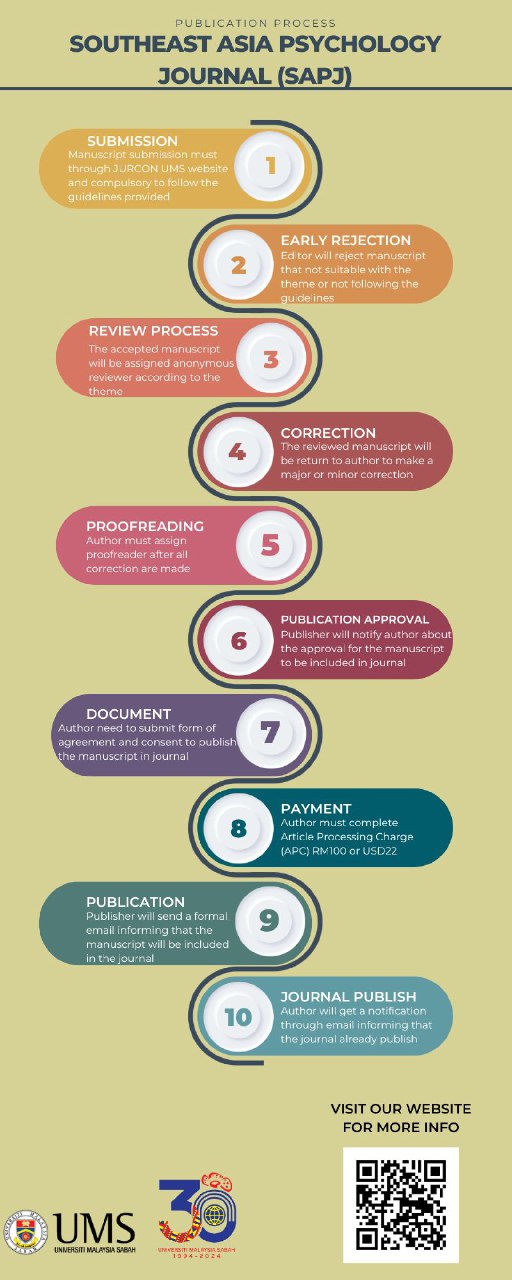THRIVING IN SINGLEHOOD: COMPARING THE SUBJECTIVE WELL-BEING BETWEEN MALE AND FEMALE
DOI:
https://doi.org/10.51200/sapj.v12i1.5074Keywords:
Subjective Well-Being, Singlehood, Emerging Adults, GenderAbstract
This study aims to measure the level of subjective well-being (SWB) among emerging adults who are single and examine if there is any difference relating to gender. A total of 199 emerging adults participated in an online survey that assessed subjective well-being (using Satisfaction with Life Scale and Positive Affect and Negative Affect Schedule). The current study reveals a prevalent high level of life satisfaction among the majority of emerging adults in this study (76.88%), and a relatively balanced distribution on positive affect (52.26%) and negative affect (54.77%). Results of a t-test revealed that males scored higher than females on positive affect dimension. However, no significant difference was found between male and female in term of life satisfaction and negative affect dimensions in SWB. These findings provide a deeper insight into the SWB of emerging adults who are single by looking at SWB across the three dimensions. Gender-related source of stress may extend into emerging adulthood for females, thus explaining the lower positive affect compared to males. Despite the emphasis on romantic engagement in the Emerging Adulthood Theory, the study highlights that emerging adults who are single can still thrive. These findings have implications for societal perceptions of singlehood in Malaysia and warrant the need for future research to understand the well-being of individuals within the context of emerging adulthood in the country.
References
Akbağ, M., & Ümmet, D. (2017). Predictive role of grit and basic psychological needs satisfaction on subjective well-being for young adults. Journal of Education and Practice, 8(26), 127-135.
Alwi, A. H., & Lourdunathan, P. (2020). Challenges and well-being of single women living in Malaysia. The Journal of Behavioral Science,15(1), 1-18. https://so06.tci-thaijo.org/index.php/IJBS/article/view/165604
Amati, V., Meggiolaro, S., Rivellini, G., & Zaccarin, S. (2018). Social relations and life satisfaction: The role of friends. Genus, 74(1), 7. https://doi.org/10.1186/s41118-018-0032-z
Arnett, J. J. (2000). Emerging adulthood: A theory of development from the late teens through the twenties. American Psychologist, 55(5), 469-480. https://doi.org/10.1037/0003-066X.55.5.469
Batz-Barbarich, C., Tay, L., Kuykendall, L., & Cheung, H. K. (2018). A meta-analysis of gender differences in subjective well-being: Estimating effect sizes and associations with gender inequality. Psychological Science, 29(9), 1491-1503. https://doi.org/10.1177/0956797618774796
Beckmeyer, J. J., & Cromwell, S. (2019). Romantic relationship status and emerging adult well-being: Accounting for romantic relationship. Emerging Adulthood, 7(4), 304-308. https://doi.org/10.1177/2167696818772653
Böger, A., & Huxhold, O. (2018). Do the antecedents and consequences of loneliness change from middle adulthood into old age? Developmental Psychology, 54(1), 181-197. https://doi.org/10.1037/dev0000453
Bookwala, J., & Fekete, E. (2009). The role of psychological resources in the affective well-being of never-married adults. Journal of Social and Personal Relationships, 26(4), 411-428. https://doi.org/10.1177/0265407509339995
Côté, J. E. (1997). An empirical test of the identity capital model. Journal of Adolescence, 20(5), 421-437. https://doi.org/10.1006/jado.1997.0111
Connolly, J. A., & McIsaac, C. (2009). Romantic relationships in adolescence. In R. M. Lerner & L. Steinberg (Eds.), Handbook of adolescent psychology: Contextual influences on adolescent development (pp. 104–151). John Wiley & Sons, Inc. https://doi.org/10.1002/9780470479193.adlpsy002005
Coplan, R. J., Rose-Krasnor, L., Weeks, M., Kingsbury, A., Kingsbury, M., & Bullock, A. (2013). Alone is a crowd: Social motivations, social withdrawal, and socioemotional functioning in later childhood. Developmental Psychology, 49(5), 861-875. https://doi.org/10.1037/a0028861
Davila, J. (2008). Depressive symptoms and adolescent romance: Theory, research, and implications. Child Development Perspectives, 2(1), 26–31. https://doi.org/10.1111/j.1750-8606.2008.00037.x
Department of Statistics Malaysia. (2019, November 27) Marriage and divorce statistics, Malaysia, 2019. https://www.dosm.gov.my/portal-main/release-content/marriage-and-divorce-statistics-malaysia-2019
Department of Statistics Malaysia. (2023, November 23) Marriage and divorce statistics, Malaysia, 2023. https://www.dosm.gov.my/portal-main/release-content/marriage-and-divorce-malaysia-
Diener, E. (1984). Subjective well-being. Psychological Bulletin, 95(3), 542-575. https://doi.org/10.1037/0033-2909.95.3.542
Diener, E., Emmons, R. A., Larsen, R. J., & Griffin, S. (1985). The Satisfaction with Life Scale. Journal of Personality Assessment,49(1), 71-75. https://doi.org/10.1207/s15327752jpa4901_13
Diener, E., Suh, E., & Oishi, S. (1997). Recent findings on subjective well-being. Indian Journal of Clinical Psychology, 24(1), 25-41.
Dush, C. K., & Amato, P. R. (2005). Consequences of relationship status and quality for subjective well-being. Journal of Social and Personal Relationships, 22(5), 607-627. https://doi.org/10.1177/0265407505056438
Furman, W., & Collibee, C. (2014). A matter of timing: Developmental theories of romantic involvement and psychosocial adjustment. Development and Psychopathology, 26, 1149-1160. https://doi.org/10.1017/s0954579414000182
Gazelle, H. (2008). Behavioral profiles of anxious solitary children and heterogeneity in peer relations. Developmental Psychology, 44(6), 1604-1624. https://doi.org/10.1037/a0013303
Gillen, M. M., & Lefkowitz, E. S. (2009). Emerging adults’ perceptions of messages about physical appearance. Body Image, 6(3), 178-185. https://doi.org/10.1016/j.bodyim.2009.02.002
Huang, S., & Turnage, A. (2022). Societal attitudes towards the single woman – a metaphor analysis. Pennsylvania Communication Annual, 78(1), 38-53.
Jovanović, V., & Joshanloo, M. (2021). The contribution of positive and negative affect to life satisfaction across age. Applied Research in Quality of Life, 17, 511-524. https://doi.org/10.1007/s11482-020- 09903-5
Kornilaki, E. N. (2022). The psychological effect of COVID-19 quarantine on Greek young adults: Risk factors and the protective role of daily routine and altruism. International Journal of Psychology, 57(1), 33- 42. https://doi.org/10.1002/ijop.12767
Lee, G. R., Seccombe, K., & Shehan, C. L. (1991). Marital status and personal happiness: An analysis of trend data. Journal of Marriage and the Family, 53(4), 839-844. https://doi.org/10.2307/352991
Li, N. P., Yong, J. C., Tov, W., Sng, O., Fletcher, G. J. O., Valentine, K. A., Jiang, Y. F., & Balliet, D. (2013). Mate preferences do predict attraction and choices in the early stages of mate selection. Journal of Personality and Social Psychology, 105(5), 757-776. https://doi.org/10.1037/a0033777
Malaysian Communications and Multimedia Commission (MCMC; 2020,December 29). Internet Users Survey 2020: Infographic. https://www.mcmc.gov.my/skmmgovmy/media/General/pdf/IUS-2020-Infographic.pdf
Ochnik, D. (2016). Do Polish never-married singles feel stigmatized? In K. Adamczyk & K. W. Libron (Eds.), Singlehood from individual and social perspective (pp. 150-186).
Oh, J., Chopik, W. J., & Lucas, R. E. (2022). Happiness singled out: Bidirectional associations between singlehood and life satisfaction. Personality and Social Psychology Bulletin, 48(11), 1597-1613. https://doi.org/10.1177/01461672211049049
Ortuño-Sierra, J., Santarén-Rosell, M., de Albéniz, A. P., & Fonseca-Pedrero, E. (2015). Dimensional structure of the Spanish version of the Positive and Negative Affect Schedule (PANAS) in adolescents and young adults. Psychological Assessment, 27(3), e1–e9. https://doi.org/10.1037/pas0000107
Rhoades, G. K., Kamp Dush, C. M., Atkins, D. C., Stanley, S. M., & Markman, H. J. (2011). Breaking up is hard to do: The impact of unmarried relationship dissolution on mental health and life satisfaction. Journal of Family Psychology, 25(3), 366-374. https://doi.org/.org/10.1037/a0023627
Swami, V., Barron, D., & Furnham, A. (2022). Appearance orientation and dating anxiety in emerging adults: Considering the roles of appearance-based rejection sensitivity, social physique anxiety, and self-compassion. Archives of Sexual Behavior, 51, 3981-3992. https://doi.org/10.1007/s10508-022-02367-8
Shulman, S., & Connolly, J. (2013). The challenge of romantic relationships in emerging adulthood: Reconceptualization of the field. Emerging Adulthood, 1(1), 27-39. https://doi.org/10.1177/2167696812467330
Tan, C. S., Cheng, S. M., & George, S. (2021). Development and validation of the Attitudes toward Singlehood Scale among undergraduate students in Malaysia and India. Collabra: Psychology, 7(1). https://doi.org/10.1525/collabra.24808
Taniguchi, E., & Ebesu, A. S. H. (2019). Effects of physical appearance social comparisons and perceived attainability of an ideal body on body dissatisfaction and weight-management behaviors among young Japanese women. Japanese Psychological Research, 62(4). https://doi.org/10.1111/jpr.12264
Tay, L., Ng, V., Kuykendall, L., & Diener, E. (2014). Demographic factors and worker well-being: An empirical review using representative data from the United States and across the world. In P. L. Perrewé, C.C. Rosen, & J. R. B. Halbesleben (Eds.), The role of demographics in occupational stress and well-being (pp. 235-283). Emerald Group Publishing. https://doi.org/10.1108/S1479- 355520140000012007
Watson, D., Clark, L. A., & Tellegen, A. (1988). Development and validation of brief measures of positive and negative affect: The PANAS scales. Journal of Personality and Social Psychology, 54(6), 1063-1070. https://doi.org/10.1037//0022-3514.54.6.1063
Yaremtchuk, S. V. (2014). Age, gender and life satisfaction in early adulthood in the Far East of Russia. Life Science Journal, 11(11s), 161-165.








